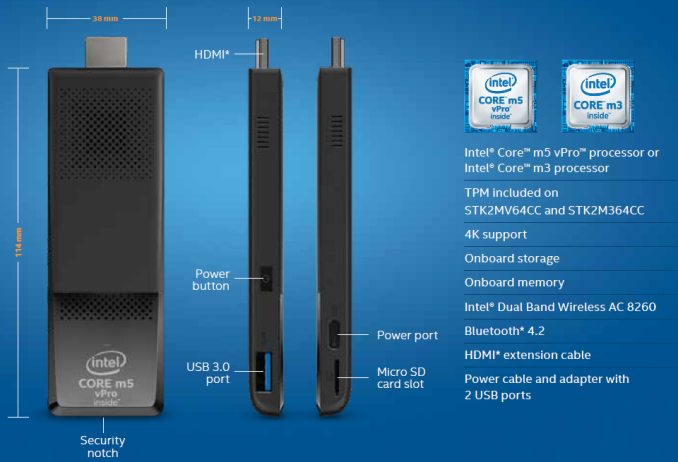The Intel Compute Stick (Core m3-6Y30) Review
by Ganesh T S on June 27, 2016 8:00 AM EST- Posted in
- Systems
- Intel
- Core M
- Skylake
- HDMI Stick
- Compute Stick
Miscellaneous Aspects and Concluding Remarks
Intel has also been putting some effort on the software side for the Compute Stick platform. One of the main problems with the platform is the limited availability of USB ports. This is somewhat alleviated in the Core M version, thanks to the two USB 3.0 ports in the power adapter. In certain situations (such as the 'entertainment' use-case), the consumer often has a second screen available (either a tablet or a smartphone). Intel has a free Android / iOS app - the Intel Remote Keyboard - to take advantage of the second screen.
The host application comes pre-installed on the Compute Stick and is active at startup as a service. Therefore, one can use it to even enter credentials for system login. It allows the second screen keyboard to act as the primary keyboard for the Compute Stick and the screen itself to act as a trackpad for the mouse pointer on the Compute Stick's display. In our evaluation, the app worked well. Our only wish is for the in-built keyboard in the app to have a 'Tab' key, and the keyboard to work properly when using a Powershell or Command Prompt window.
Moving on to the business end of the review, we complained in our previous Compute Stick reviews that 32GB of primary storage does not cut it on any computing device other than a tablet or smartphone. Fortunately, the Core m3-6Y30 Compute Stick solves that problem. The two USB 3.0 ports on the power adapter are very welcome. The Wi-Fi solution (2x2 AC8260 802.11ac PCIe WLAN) is also top-notch. The system is also able to bitstream HD audio for HTPC applications. BIOS options t have fine-grained control over the fans is also a nice aspect. Performance-wise, it is hard to find faults when keeping the form factor in mind.
The only complaint we have is the $390 price point. Even though that price includes the OS license, we find it difficult to recommend it in the home PC market - the Cherry Trail Compute Stick and the other sub-$150 Compute Sticks look to be a better option.
However, the SMB / enterprise market might find the Core M Compute Sticks more to their liking. Price is not such a huge deterrent in that market. The availability of vPro features (in the Core m5 model) and TPM (trusted platform module) shows that Intel intends these systems to be primarily adopted in that market segment.











105 Comments
View All Comments
Vaz - Tuesday, June 28, 2016 - link
Product photography seems to have hit rock bottom in anandtech reviews.tamalero - Tuesday, June 28, 2016 - link
The cheer size of the power block kinda makes the stick size useless, doesnt it?xodusgenesis - Tuesday, June 28, 2016 - link
Can this handle software decode of H.265? Or does it stress the CPU too much?ganeshts - Tuesday, June 28, 2016 - link
There is hybrid decoding for HEVC 8b - I expect it will work ok for 24p content, even 4K.However, 4Kp60 or HEVC 10b will be a no-go.
Kinematics - Wednesday, June 29, 2016 - link
What about 10-bit h264?It's what's most disappointing in all this small form-factor reviews: At what point is this product *not* going to be useful to you? And all it ever does is cover stuff that I know already is going to work fine. Since I know that 10-bit won't be hardware accelerated (whereas everything that's tested is), it's impossible to even guess at how it compares in areas that you actually need a reviewer to look at.
DonMiguel85 - Tuesday, June 28, 2016 - link
I'm still waiting for that GTX 960 reviewnfriedly - Tuesday, June 28, 2016 - link
I have one of these and one of the m5 versions and I pretty much agree with Anandtech's conclusions. They're the first compute stick that feel "fast enough" for basic office/browsing/htpc tasks. But they're definitely a bit on the expensive side.From what I've seen elsewhere and my personal experience the m5 version is a little faster for bursty workloads, but about on par with the m3 for anything sustained. The graphics might be a bit more powerful, though. Probably not worth the price difference.
Also, on a different topic, Anandtech seriously needs to put some improvements into the commenting system. I had to get to page 4 just to find a single comment about the article... A way to collapse comment threads would probably be good enough, although voting or some kind of moderation might be even better.
lhorror - Wednesday, June 29, 2016 - link
core m3 version on video - https://www.youtube.com/watch?v=AWcULkwryH4piasabird - Wednesday, June 29, 2016 - link
I would like to see comparison of this to something like an STX system where you can use normal DDR4 Ram and a standard CPU, with an M.2 SSD drive, and also an ITX system. All this to determine if it is worth it and also what are the advantages to having a larger drive and more RAM.grand_puba - Friday, July 1, 2016 - link
This website is going from bad to worse. There are few reviews and at least half of them are about cases and shit like that. I am going to remove you from my bookmarks.